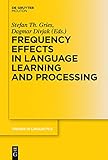Frequency Effects in Language. Volume 1, Frequency Effects in Language Learning and Processing / ed. by Stefan Th. Gries, Dagmar Divjak.
Material type: TextSeries: Trends in Linguistics. Studies and Monographs [TiLSM] ; 244.1Publisher: Berlin ; Boston : De Gruyter Mouton, [2012]Copyright date: ©2012Description: 1 online resource (243 p.)Content type:
TextSeries: Trends in Linguistics. Studies and Monographs [TiLSM] ; 244.1Publisher: Berlin ; Boston : De Gruyter Mouton, [2012]Copyright date: ©2012Description: 1 online resource (243 p.)Content type: - 9783110273762
- 9783110274059
- online - DeGruyter
- Issued also in print.
| Item type | Current library | Call number | URL | Status | Notes | Barcode | |
|---|---|---|---|---|---|---|---|
 eBook
eBook
|
Biblioteca "Angelicum" Pont. Univ. S.Tommaso d'Aquino Nuvola online | online - DeGruyter (Browse shelf(Opens below)) | Online access | Not for loan (Accesso limitato) | Accesso per gli utenti autorizzati / Access for authorized users | (dgr)9783110274059 |
Browsing Biblioteca "Angelicum" Pont. Univ. S.Tommaso d'Aquino shelves, Shelving location: Nuvola online Close shelf browser (Hides shelf browser)
Frontmatter -- Table of contents -- Introduction -- What can we count in language, and what counts in language acquisition, cognition, and use? -- Are effects of word frequency effects of context of use? An analysis of initial fricative reduction in Spanish -- What statistics do learners track? Rules, constraints and schemas in (artificial) grammar learning -- Relative frequency effects in Russian morphology -- Frequency, conservative gender systems, and the language-learning child: Changing systems of pronominal reference in Dutch -- Frequency Effects and Transitional Probabilities in L1 and L2 Speakers’ Processing of Multiword Expressions -- You talking to me? Corpus and experimental data on the zero auxiliary interrogative in British English -- The predictive value of word-level perplexity in human sentence processing: A case study on fixed adjective-preposition constructions in Dutch -- Index
restricted access online access with authorization star
http://purl.org/coar/access_right/c_16ec
The volume contains a collection of studies on how the analysis of corpus and psycholinguistic data reveal how linguistic knowledge is affected by the frequency of linguistic elements/stimuli. The studies explore a wide range of phenomena , from phonological reduction processes and palatalization to morphological productivity, diachronic change, adjective preposition constructions, auxiliary omission, and multi-word units. The languages studied are Spanish and artificial languages, Russian, Dutch, and English. The sister volume focuses on language representation.
Issued also in print.
Mode of access: Internet via World Wide Web.
In English.
Description based on online resource; title from PDF title page (publisher's Web site, viewed 28. Feb 2023)









